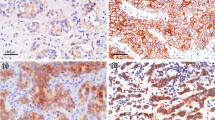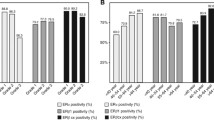Abstract
The aim of this study was to analyze the clinicopathologic significance of ERα protein that localized in the cell cytoplasm and/or cell membrane of human breast cancer and explore what kind of protein that the cytoplasm/membrane ERα belongs to. ERα expressions in 61 cases of breast cancer are detected by immunohistochemistry, grouping is performed according to the positive staining of different subcellular localizations, the expression levels of ERα66 and ERα36 in cancer tissues of groups with different subcellular localizations are detected by Western blot, and correlation between the indicators and its clinicopathologic significance are analyzed by combining with the clinical pathological parameters. Localization by immunohistochemical staining in breast cancer cells shows that there are two types of ERα—in the cell nucleus and/or the cell membrane; there are four groups as ER nuclear staining positive + membrane staining positive (N+/C+), 23 cases; ER nuclear staining positive + membrane staining negative (N+/C−), 16 cases; ER nuclear staining negative + membrane staining positive (N−/C+), 8 cases; and ER nuclear staining negative + membrane staining negative (N+/C+), 14 cases. ER expression in the cytoplasm and/or membrane of cancer cells is correlated with the high expression of HER-2, the lymphatic metastasis, and the late clinical stage. Western blot results show that ER protein in breast cancer tissues mainly consists of ERα66 and ERα36 bands, and among all the groups, all the cases from the N+/C+ group (n = 23) have both ERα66 and ERα36 expressions; in the N+/C− group, 14 cases of which only have the ERα66 expression without ERα36 expression and 2 cases of which have both ERα66 and ERα36 expression; all the cases from the N−/C+ group have only the ERα36 expression without ERα66 expression; and in the N−/C− group, there is no either ERα66 or ERα36 expression. The expression level of ERα36 relates to the age of patients, the menopause, the lymphatic metastasis, and the tumor size (p < 0.05), and no statistical significance was shown between it and the family history of patients as well as the clinical staging parameters (p > 0.05). The expression level of ERα66 relates to the tumor size of breast cancer and the clinical stages (p < 0.05), and no statistical significance was shown between it and the age of patients, the history of menopause, and the family history as well as the parameters of lymphatic metastasis (p > 0.05). ER protein expression of human breast cancer is localized in the cell nucleus and/or the cell membrane, with poor prognosis of cytoplasm/membrane-positive patients; ER protein that localized in the nucleus is mainly ERα66 and that localized in the cytoplasm and/or membrane is mainly ERα36.


Similar content being viewed by others
References
Elizabeth, M., Hammond, H., Hayes, D. F., et al. (2010). American Society of Clinical Oncology/College of American Pathologists Guideline Recommendations for immunohistochemical testing of estrogen and progesterone receptors in breast cancer. Journal of Clinical Oncology, 28(16), 2784–2795.
Kraus, W. L., McInerney, E. M., & Katzenellenbogen, B. S. (1995). Ligand-dependent, transcriptionally productive association of the amino- and carboxyl-terminal regions of a steroid hormone nuclear receptor. Proceedings of the National Academy Sciences of the United States of America, 92(26), 12314–12318.
Wang, L., Ji, Z. H., Chen, D. D., Wang, H. X., & Zou, W. (2007). Progress of caveolin and its role in brain. Progress in Biochemistry and Biophysics, 34(5), 449–453. (Chinese, English abstract).
Kang, L., & Wang, Z. Y. (2010). Breast cancer cell growth inhibition by phenethyl isothiocyanate is associated with down-regulation of oestrogen receptor-alpha36. Journal of Cellular and Molecular Medicine, 14(6B), 1485–1493.
Tong, J. S., Zhang, Q. H., Wang, Z. B., Li, S., Yang, C. R., Fu, X. Q., et al. (2010). ER-α36, a novel variant of ER-α, mediates estrogen-stimulated proliferation of endometrial carcinoma cells via the PKCδ/ERK pathway. PLoS ONE, 5(11), 15408.
Deng, H., Huang, X., Fan, J., Wang, L., Xia, Q., Yang, X., et al. (2010). A variant of estrogen receptor-alpha, ER-alpha36 is expressed in human gastric cancer and is highly correlated with lymph node metastasis. Oncology Reports, 24(1), 171–176.
Zheng, Y., Zhang, J., Xu, Z. Z., Sheng, J. M., Zhang, X. C., Wang, H. H., et al. (2010). Quantitative profiles of the mRNAs of ER-alpha and its novel variant ER-alpha36 in breast cancers and matched normal tissues. Journal of Zhejiang University Science B, 11(2), 144–150.
Author information
Authors and Affiliations
Corresponding authors
Rights and permissions
About this article
Cite this article
Li, L., Wang, Q., Lv, X. et al. Expression and Localization of Estrogen Receptor in Human Breast Cancer and Its Clinical Significance. Cell Biochem Biophys 71, 63–68 (2015). https://doi.org/10.1007/s12013-014-0163-6
Published:
Issue Date:
DOI: https://doi.org/10.1007/s12013-014-0163-6




